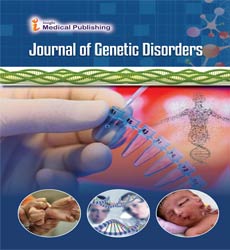Genetic Basis of Monogenic Epilepsies
Isa Abdi Rad*
Department of Medical Genetics, Motahari Teaching Hospital, Urmia University of Medical Sciences, West Azerbaijan, Iran
- *Corresponding Author:
- Isa Abdi Rad
Department of Medical Genetics
Motahari Teaching Hospital
Urmia University of Medical Sciences
West Azerbaijan, Iran
Tel: +0914440 5829
Fax: +00984432240166
E-mail: isaabdirad@yahoo.com
Received Date: August 28, 2017; Accepted Date: August 31, 2017; Published Date: September 05, 2017
Citation: Rad IA (2017) Genetic Basis of Monogenic Epilepsies. J Genet Disord. 1:2.
Editorial
Epilepsy as a common neurologic disorder is defined as at least two unprovoked seizures more than 24 hours apart, which occur in 0.5-0.8 of population. Approximately, half of all epilepsies are idiopathic which may have a genetic basis with a monogenic or polygenic pattern of inheritance, so that, the risk of developing epilepsy is 2 to 5 times higher in the relatives of patients with epilepsy [1,2]. Determining the genetic basis of epilepsies would be very helpful in classification, unraveling mechanism and pathogenesis of epilepsies, and in genetic counseling. Monogenic pattern of inheritance has been recognized in only about 1-2% of the idiopathic epilepsies, so, genetic involvement and underlying mechanism still remain unclear in the majority of idiopathic epilepsies [3]. Most of monogenic epilepsies are voltage-gated ion channelopathies such as sodium, potassium, and chloride channelopathies, or defects in neurotransmitter receptors such as GABAA receptor, and nicotinic acetylcholine receptor [4-9].
Most monogenic epilepsies with identified genes or loci have autosomal dominant pattern of inheritance, although, all other patterns of inheritance are also reported. Autosomal recessive inheritance is common in epilepsies with an early age of onset and with a progressive course, and sometimes may be associated with other movement disorders such as autosomal recessive rolandic epilepsy with paroxysmal exercise induced dystonia and writer's cramp which mapped to chromosome 16p12-11.2 [10].
Autosomal dominant epilepsies with identified genes can be classified according to the involved proteins such as channelopathies or receptors. Benign familial neonatal convulsions are a voltage-gated potassium channelopathy due to mutations in KCNQ2 and KCNQ3 genes. Voltage-gated sodium channelopathies include benign familial neonatal-infantile seizures (SCN2A gene), generalized epilepsy with febrile seizures plus (SCN1A, SCN1B, and SCN2A genes) and Dravet’s syndrome or severe myoclonic epilepsy in infancy (SCN1A gene). Generalized epilepsy with febrile seizures plus can resulted from mutations in γ2 subunit of the GABAA receptor (GABRG2 gene). Mutation in α1 subunit of the GABAA (GABRA1 gene) results in Juvenile myoclonic epilepsy.
Autosomal dominant nocturnal frontal lobe epilepsy resulted from mutations in α4 and β2 subunits of nicotinic acetylcholine receptor (CHRNA4 and CHRNB2 genes). Defect in Epitempin protein results in familial lateral temporal-lobe epilepsy with auditory symptoms (LGI1 gene) which is an autosomal dominant disorder. Infantile convulsions and choreoathetosis is also autosomal dominant epilepsy resulted from mutations in KST1 gene. Obviously, the list of epilepsies with Mendelian inheritance will be longer with determination of related genes in future.
In summary, the genetic factors play an important role in epilepsy. Determination of genetic basis of epilepsy would be essential and very helpful in genetic counseling and prevention of disease in the high risk families via prenatal diagnosis.
References
- Andermann E (1985) Genetic aspects of the epilepsies. In: Sakai T, Tsuboi T, editors. Genetic aspects of human behavior. Tokyo: Igaku-Shoin pp: 129-145.
- Berkovic SF, Howell RA, Hay DA, Hopper JL (1998) Epilepsies in twins: genetics of the major epilepsy syndromes. Ann Neurol 43: 435-445.
- Weber YG, Lerche H (2008) Genetic mechanisms in idiopathic epilepsies. Dev Med Child Neurol 50: 648-654.
- Cossette P, Loukas A, Lafreniere RG, Rochefort D, Ragsdale DS, et al. (2003) Functional characterization of the D188V mutation in neuronal voltage-gated sodium channel causing generalized epilepsy with febrile seizures plus (GEFS). Epilepsy Res 53: 107-117.
- Charlier C, Singh NA, Ryan SG, Lewis TB, Reus BE, et al. (1998) A pore mutation in a novel KQT-like potassium channel gene in an idiopathic epilepsy family. Nat Genet 18: 53-55.
- Haug K, Warnstedt M, Alekov AK, Sander T, Ramírez A, et al. (2003) Mutations in CLCN2 encoding a voltage-gated chloride channel are associated with idiopathic generalized epilepsies. Nat Genet 33: 527-532.
- Baulac S, Huberfeld G, Gourfinkel-An I, Mitropoulou G, Beranger A, et al. (2001) First genetic evidence of GABAA receptor dysfunction in epilepsy: a mutation in the γ 2-subunit gene. Nat Genet 28: 46-48.
- Fusco MD, Becchetti A, Patrignani A, Annesi G, Gambardella A, et al. The nicotinic receptor β2 subunit is mutant in nocturnal frontal lobe epilepsy. Nat Genet 26: 275-276.
- Poduri A, Lowenstein D (2011) Epilepsy genetics—Past, present, and future. Curr Opin Genet Dev 21: 325-332.
- Guerrini R, Bonanni P, Nardocci N, Parmeggiani L, Piccirilli M, et al. (1999) Autosomal recessive rolandic epilepsy with paroxysmal exercise-induced dystonia and writer’s cramp: delineation of the syndrome and gene mapping to chromosome 16p12-11.2. Ann Neurol 45: 344-352.
Open Access Journals
- Aquaculture & Veterinary Science
- Chemistry & Chemical Sciences
- Clinical Sciences
- Engineering
- General Science
- Genetics & Molecular Biology
- Health Care & Nursing
- Immunology & Microbiology
- Materials Science
- Mathematics & Physics
- Medical Sciences
- Neurology & Psychiatry
- Oncology & Cancer Science
- Pharmaceutical Sciences
